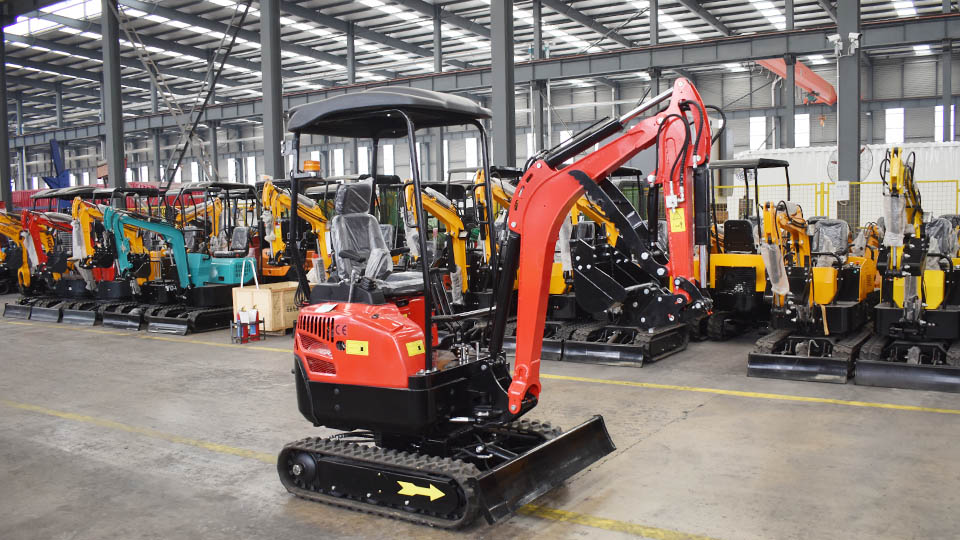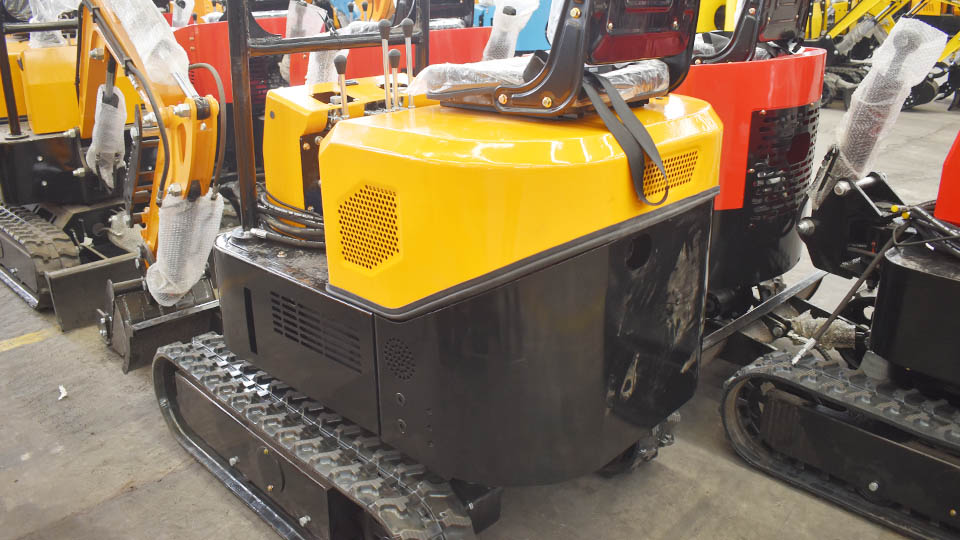Case Study: How One Company Increased Efficiency with a New Excavator
Company Profile:
Company Name: TerraForm Earthworks Inc.
Location: Pacific Northwest, USA
Industry: Civil Construction & Site Preparation
Fleet Size (pre-acquisition): 12 heavy equipment units (excavators, dozers, loaders, skid steers, graders)
Key Services: Commercial and residential site development, land clearing, mass excavation, trenching, utility installation, road building.
Challenge: Lagging project timelines, increasing fuel costs, frequent maintenance downtime on older excavator models, and a growing backlog of complex earthmoving projects.
The Challenge: A Fleet Nearing Its Limits
TerraForm Earthworks Inc., a well-established civil construction company in the Pacific Northwest, had built a solid reputation over 15 years for delivering quality earthwork services. However, by late 2023, the company found itself at a critical juncture. A significant portion of its excavator fleet consisted of older models, ranging from 8 to 15 years in age, with accumulated thousands of hours.
These aging machines, while reliable in their prime, were increasingly becoming a liability:
Decreased Fuel Efficiency: Older hydraulic systems and less efficient engines consumed significantly more fuel, directly impacting operational costs, especially with fluctuating diesel prices.
Increased Downtime and Maintenance Costs: Worn components, frequent hydraulic leaks, and unexpected breakdowns led to more time spent in the shop, delaying project schedules and incurring substantial repair expenses. Replacement parts for older models were also becoming harder to source.
Lower Productivity: Older excavators typically offered less power, slower cycle times, and less precise controls compared to modern machines, limiting their ability to handle larger, more complex projects efficiently.
Operator Fatigue: Less ergonomic cabs and higher vibration levels in older machines contributed to operator fatigue, potentially affecting precision and safety over long shifts.
Limited Versatility: The hydraulic systems on some older models struggled to power newer, more demanding attachments, limiting the scope of work they could perform.
Competitive Disadvantage: Newer competitors were deploying state-of-the-art equipment, allowing them to bid more aggressively on projects and complete them faster.
TerraForm's project managers were reporting consistent delays, budget overruns due to fuel and maintenance, and a general sense of being stretched thin. The company realized that continued reliance on their aging fleet would stifle growth and eventually erode their market position. The need for a significant upgrade was clear.
The Decision: Strategic Investment in a New Excavator
After extensive internal discussions, cost-benefit analyses, and consultations with equipment dealers, TerraForm Earthworks made the strategic decision to invest in a brand-new excavator. The goal was not merely to replace an old machine, but to acquire a piece of equipment that would significantly boost efficiency, reduce operating costs, and enhance their capacity for larger, more profitable projects.

Key Criteria for Selection:
Fuel Efficiency: A top priority to combat rising operational costs.
Reliability & Durability: To minimize downtime and extend service life.
Power & Performance: To handle tough digging conditions and heavy loads efficiently.
Operator Comfort & Technology: To reduce fatigue and leverage modern digital tools for improved precision.
Versatility & Attachment Capability: To expand the range of services offered.
Dealer Support & Service: A strong local dealer network for parts, service, and technical expertise.
After evaluating several manufacturers, TerraForm Earthworks selected the Caterpillar 336 GC Next Gen Excavator. This model was chosen for its reputation for balanced performance, advanced fuel efficiency, integrated technology, and Caterpillar's extensive dealer network in the Pacific Northwest.
Implementation: Integrating the New Machine
The acquisition process involved more than just purchasing the excavator. TerraForm implemented a structured approach to integrate the new asset seamlessly into their operations:
Operator Training: Two lead operators, Mark and Sarah, who had extensive experience with the older fleet, were selected for specialized training. This included:
Classroom Sessions: Covering the new machine's advanced controls, maintenance procedures, safety features, and onboard technology (e.g., Cat GRADE with 2D, Payload system).
Hands-On Training: Intensive practical sessions with a certified Caterpillar instructor on a controlled site, focusing on mastering the machine's enhanced hydraulics, precision controls, and optimal operating techniques.
Cross-Training: Mark and Sarah then became internal trainers, cross-training other operators on the new machine's core functionalities, ensuring a broader base of skilled operators.
Fleet Management System Integration: The new excavator was immediately integrated into TerraForm's telematics system (which leveraged Caterpillar's Cat Link technology). This allowed for real-time monitoring of:
Fuel consumption
Machine hours
Location and operational status
Maintenance alerts
Performance metrics (e.g., payload data, cycle times)
Strategic Project Assignment: The Cat 336 GC was initially deployed on two key projects that had been experiencing delays due to the limitations of the older equipment:
Project A: Large Commercial Building Foundation: Required significant bulk excavation, precise trenching for utilities, and high-volume material loading.
Project B: Multi-Phase Residential Subdivision: Involved extensive land clearing, mass grading, and numerous utility trenching runs.
Results: Tangible Improvements in Efficiency and Profitability
The impact of the new Caterpillar 336 GC on TerraForm Earthworks' operations was immediate and significant. The company meticulously tracked key performance indicators (KPIs) over the first six months of the excavator's operation, comparing them against the performance of the older machines on similar tasks.
1. Fuel Efficiency Gains:
Observation: The Cat 336 GC consistently demonstrated 20-25% better fuel efficiency compared to the older excavators in similar operating conditions.
Impact: This translated to substantial savings on diesel costs, directly improving project profitability. For example, on a typical 10-hour workday, the new excavator consumed approximately 15-20 gallons less fuel than an older equivalent, leading to thousands of dollars in savings per month across multiple projects.
2. Reduced Downtime and Maintenance Costs:
Observation: Over the six-month period, the new excavator experienced zero unscheduled downtime for major repairs. Routine maintenance was minimal and easily scheduled during non-operational hours.
Impact: Eliminated costly emergency repairs and minimized project delays. The older machines, by contrast, had accumulated 40-60 hours of unscheduled downtime each over the same period, costing TerraForm an estimated $8,000-$12,000 per machine in lost productivity and repair bills.

3. Enhanced Productivity and Cycle Times:
Observation: The Cat 336 GC consistently delivered 15-20% faster cycle times for digging, loading, and material placement. Its greater hydraulic power and responsive controls allowed for larger bucket loads and quicker movements.
Impact: Accelerated project timelines. Project A, which was initially projected to take 8 weeks for excavation and utility trenching with older equipment, was completed in just under 6.5 weeks with the new excavator as the primary machine. This 18% reduction in completion time allowed TerraForm to move resources to the next project sooner, boosting overall project throughput.
4. Improved Precision with Integrated Technology:
Observation: The integrated Cat GRADE with 2D system dramatically improved the accuracy of digging and trenching. Operators could achieve target depths and slopes without relying as heavily on traditional survey methods or constant manual checks.
Impact: Reduced rework and material waste. On Project B, utility trenching, which typically required multiple passes and manual adjustments, was completed with almost perfect grade on the first pass, saving significant time and labor costs associated with fine grading.

5. Increased Operator Satisfaction and Reduced Fatigue:
Observation: Operators Mark and Sarah reported significantly less fatigue due to the ergonomic cab design, reduced vibration, and intuitive controls. The quiet cabin environment also contributed to better focus.
Impact: While difficult to quantify directly, improved operator comfort is known to enhance safety, reduce errors, and improve long-term retention of skilled personnel. Operators were more efficient and productive throughout their shifts.
6. Expanded Service Capabilities:
Observation: The more powerful hydraulics of the 336 GC allowed TerraForm to confidently use larger and more specialized attachments (e.g., a heavy-duty hydraulic hammer and a larger sorting grapple) that their older machines couldn't effectively power.
Impact: Enabled TerraForm to take on demolition and complex land clearing projects that were previously outsourced or declined, diversifying their service offerings and opening new revenue streams.
Qualitative Benefits and Long-Term Outlook
Beyond the quantifiable metrics, TerraForm Earthworks experienced several qualitative benefits:
Enhanced Reputation: Faster project completion and increased efficiency bolstered TerraForm's reputation as a reliable and high-performing contractor, leading to more competitive bids and client satisfaction.
Improved Safety: Newer machines often incorporate advanced safety features, including improved visibility (cameras), stability control, and proximity sensors, contributing to a safer work environment.
Better Data for Decision-Making: The telematics data provided invaluable insights into machine utilization, operator performance, and project costs, allowing for more informed strategic decisions on future equipment investments and project planning.

Environmental Responsibility: Reduced fuel consumption also meant a smaller carbon footprint, aligning with growing client and industry expectations for environmental stewardship.
TerraForm Earthworks CEO, Robert Chen, commented, "The investment in the Cat 336 GC was a turning point for us. It wasn't just about replacing an old machine; it was about modernizing our capabilities. The efficiency gains have directly impacted our bottom line, allowing us to take on more work, complete it faster, and maintain our competitive edge. Our operators love the machine, and that translates directly into better work."
Conclusion: A Model for Strategic Equipment Investment
The case of TerraForm Earthworks Inc. serves as a compelling example of how a strategic investment in a new, technologically advanced excavator can yield significant returns. By carefully analyzing their challenges, selecting equipment that met specific needs, and implementing a robust integration plan, TerraForm was able to:
Reduce operational costs through superior fuel efficiency and minimized maintenance.
Accelerate project timelines via enhanced productivity and precision.
Improve operator performance and satisfaction.
Expand service capabilities and capture new revenue streams.
This case study underscores that for civil construction and earthmoving companies, heavy equipment is not merely an expense, but a critical asset that, when strategically chosen and deployed, can be the primary driver of efficiency, profitability, and long-term business growth. TerraForm Earthworks now plans to systematically upgrade more of its aging fleet, replicating the success achieved with their new Cat 336 GC.
Post time:Sep-25-2020
